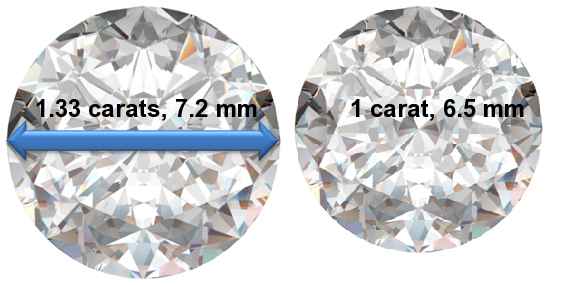Quick and Easy Buying Guide
Carat weight: 1 carat = 200 milligrams = 6.5 mm diameter. Doubling weight doesn't double diameter.
Diamond clarity: FL/IF/VVS/VS = super expensive, near perfect. SI = best value if you can check a photo for obvious inclusions (defects).
Color: D-G = colorless, expensive, only if you have money to burn. H-J = best value. Can go lower in gold metal settings than white metal.
Cut: Better cut ratings let more light into a diamond, making it sparkle more. Very important property, don't skimp here.
Set a budget and minimum cut (Premium). Go J color for gold and I/H for white metals. Go searching for SI1/SI2 clarity diamonds at James Allen. Pick a diamond with small/no inclusions. Choose a ring setting and buy it risk-free (60-day returns).
1.33 Carat Diamonds
A diamond which has a size of 1.33 carats is the same as a 133 point diamond. 1.33 carats worth of diamond gives you a stone that weighs precisely 266 mg.
Sponsored Links
A way of using numbers to help you compare diamonds is to calculate the cost per carat of diamond. Can you tell the difference between a 0.49 and a half carat diamond? Didn't think so. But there can often be quite a significant price difference - so use this fact to your advantage.
Something that can catch out men searching for a diamond for an engagement ring is forgetting to take into account where the diamond will eventually be displayed - on a woman's hand, which is usually quite a bit smaller than a man's hand.
You don't want a million answers as much as you want a few forever questions. The questions are diamonds you hold in the light. Study a lifetime and you see different colors from the same jewel. Richard Bach .
Ever looked at a similar carat size of diamond and another gemstone and wondered why the stones appeared so different in size? This is undoubtedly because different types of stones have different specific gravity densities, leading to this discrepancy in size.
There's a lot of hearsay on the internet about the average size of a diamond used in a typical diamond engagement ring - it's around half carat - but that of course doesn't give you any information about the typical clarity or colour of the diamond, and that in itself should tell you how useless that statistic is in isolation.
In terms of diamond properties, the carat weight of the diamond should be considered alongside the many other characteristics of the diamond, in order to find a diamond which is balanced and hence not let down by being of poor quality in one of these departments.


